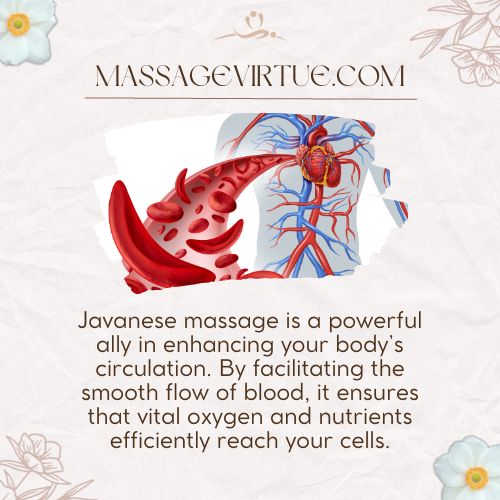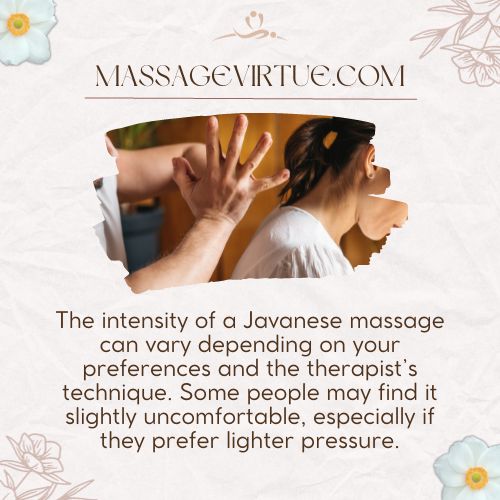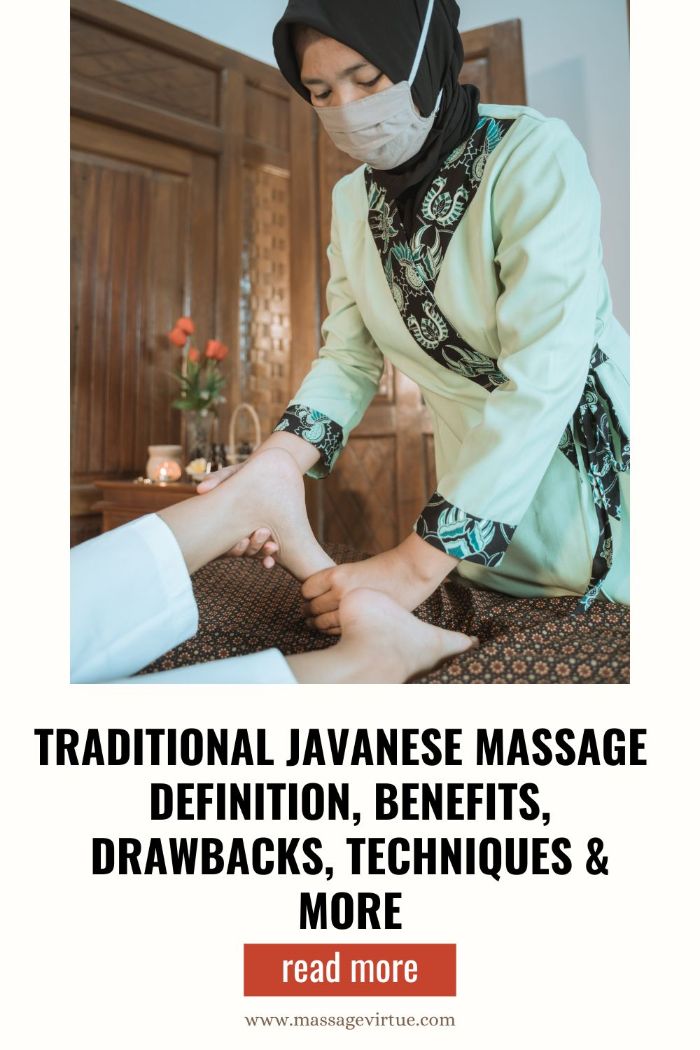If you’re someone seeking holistic healing and wellness, the world of traditional massage might hold the key to your well-being.
Traditional Javanese Massage stands out as a time-honored practice with a rich history.
In this article, we’ll delve into the world of Javanese massage, exploring its techniques, benefits, and drawbacks, and even comparing it to Thai massage.
What is a Traditional Javanese Massage?
Traditional Javanese massage, often referred to as ‘Pijat,’ is an ancient Indonesian healing art.
Javanese massage traces its roots back to the royal courts of Java, Indonesia. This technique has been passed down through generations, embodying a unique blend of cultural wisdom and holistic therapy.

Javanese massage focuses on balancing the body’s vital energy, known as ‘Prana’ or ‘Chi,’ through a series of rhythmic, flowing strokes and stretches.
It integrates elements of ancient Javanese spirituality and traditions, making it a truly unique and spiritual experience.
Traditional Javanese Massage Benefits
The benefits of traditional Javanese massage are as diverse as the techniques themselves. Here are some of the key advantages:
1. Holistic Healing
Traditional Javanese massage transcends the physical realm, offering a holistic experience that touches the mind, emotions, and spirit.
This ancient practice seeks to harmonize the intricate interplay between the body and the mind, fostering a profound sense of balance and well-being.
2. Pain Relief
If you’ve been battling chronic pain, particularly in the back, shoulders, or neck, traditional Javanese massage could be your beacon of relief.
Therapists employ specialized techniques that target problem areas, alleviating discomfort and promoting muscular healing.
3. Improved Circulation
Javanese massage is a powerful ally in enhancing your body’s circulation.

By facilitating the smooth flow of blood, it ensures that vital oxygen and nutrients efficiently reach your cells, while waste products are whisked away.
This, in turn, fosters overall well-being.
4. Increased Energy
Balancing the body’s energy flow is at the heart of Javanese massage.
By realigning your Prana or Chi, this practice rejuvenates and re-energizes you, leaving you with a newfound vitality and zest for life.
5. Better Sleep
Countless individuals have attested to the transformative impact of Javanese massage on their sleep quality.
The deep relaxation induced by this therapy often translates into nights of restful slumber, allowing you to wake up refreshed and invigorated.
6. Reduced Anxiety
The calming embrace of Javanese massage extends far beyond mere muscle relaxation.
It has the unique ability to soothe the restless mind, gently coaxing anxiety away. As the tension melts away, you’ll find yourself enveloped in a profound sense of inner peace.
7. Improved Mood
Javanese massage doesn’t just target physical knots and tension; it also works its magic on your emotional well-being.

The release of endorphins and the reduction of stress hormones during the massage frequently lead to an uplifted mood.
It’s not uncommon to emerge from a session with a brighter outlook on life.
Traditional Javanese Massage Drawbacks
While traditional Javanese massage offers numerous benefits, it’s essential to be aware of potential drawbacks:
1. Pressure Sensitivity
Some individuals may find the pressure applied during Javanese massage to be intense or uncomfortable.
It’s crucial to communicate your preferences to your therapist to ensure a comfortable experience.
2. Not Suitable for Everyone
Pregnant women, those with certain medical conditions, or recent injuries should consult a healthcare professional before receiving a Javanese massage.
Javanese Massage Techniques
Javanese massage techniques are an art form that therapists spend years mastering. Here are some of the key techniques used:
1. Kneading (Petrissage): Involves using the thumbs, fingers, and palms to knead and lift the muscles, promoting relaxation and improving circulation.
2. Stretching (Peregangan): Gentle stretches are applied to improve flexibility, reduce tension, and enhance mobility.
3. Tapping (Tepuk): A rhythmic tapping technique helps stimulate the muscles and relax the body.
4. Cupping (Gurut): Small cups are placed on the skin to create a vacuum, promoting blood flow and releasing muscle tension.
Is Javanese Massage Painful?
The intensity of a Javanese massage can vary depending on your preferences and the therapist’s technique.

Some people may find it slightly uncomfortable, especially if they prefer lighter pressure.
Communication with your therapist is key.
You should always communicate your comfort level, and they can adjust the pressure accordingly to ensure a pleasurable experience.
Javanese Massage vs. Thai Massage
To help you understand the differences between Javanese and Thai massages better, let’s compare them in a tabular form:
| Aspect | Javanese Massage | Thai Massage |
| Origin | Java, Indonesia | Thailand |
| Techniques | Kneading, Stretching, Tapping, Cupping | Stretching, Compressions, Acupressure |
| Clothing | Typically done with minimal clothing, often in undergarments | Done fully clothed, in loose and comfortable attire |
| Pressure | Pressure can be adjusted based on individual preference | Typically involves more intense pressure |
| Focus | Balancing energy flow, holistic well-being | Aligning the body’s energy, physical relief |
| Spiritual Element | Often incorporates Javanese spirituality | Less focused on spirituality |
| Duration | Sessions can vary in length | Typically 60-90 minutes |
| After-effects | Deep relaxation, improved mood, and energy | Enhanced flexibility, relief from muscle tension |
Conclusion
In conclusion, traditional Javanese massage is a holistic healing art that has stood the test of time, offering a wide range of benefits.
While it may not be suitable for everyone and can vary in intensity, the calming and rejuvenating effects of this ancient practice are undeniable.
Whether you opt for a Javanese or Thai massage, both can be incredible additions to your holistic wellness journey.
FAQs
What Is Javanese Massage Like?
Javanese massage is a traditional massage from Java, Indonesia. It’s a bit different from some other massages you might know.
It uses long, flowing strokes, gentle stretches, and sometimes pressure points.
It’s soothing and aims to make you feel relaxed and balanced, not just physically but also in your mind and spirit.
Where Did the Javanese Massage Come From?
Javanese massage comes from the island of Java in Indonesia. It’s a part of their rich cultural heritage.
People in Java have been using these massage techniques for a very long time, and it’s become a way to promote wellness and harmony in their lives.
What Are the Different Types of Balinese Massages?
Balinese massages are also from Indonesia, but they’re a bit different from Javanese massages. There are a few types of Balinese massages, including:
- Balinese Traditional Massage: This is a full-body massage that combines gentle stretches, acupressure, and essential oils to relax and rejuvenate you.
- Balinese Aromatherapy Massage: It’s similar to traditional massage but uses fragrant oils to enhance relaxation and well-being.
- Balinese Hot Stone Massage: Here, heated stones are placed on your body to help ease tension and promote deep relaxation.
What Is Javanese Lymphatic Massage?
Javanese lymphatic massage is a specialized type of Javanese massage that focuses on your lymphatic system.
This system helps your body get rid of waste and toxins.
The massage uses gentle, rhythmic strokes to stimulate lymph flow, which can boost your immune system and make you feel healthier.
What Race Is Javanese?
Javanese people are an ethnic group from Indonesia, primarily living on the island of Java.
So, the Javanese are of Indonesian ethnicity. Indonesia itself is a diverse country with many different ethnic groups, and Javanese is one of the largest and most prominent among them.


